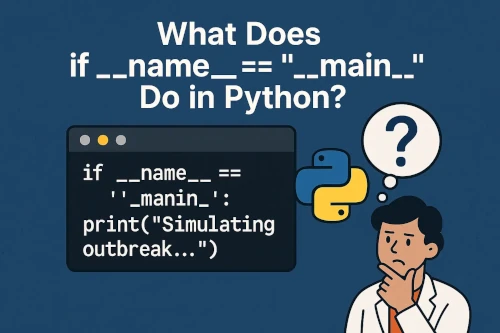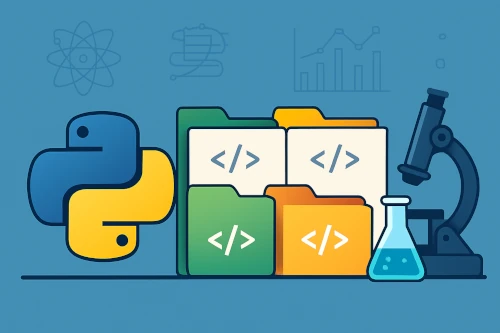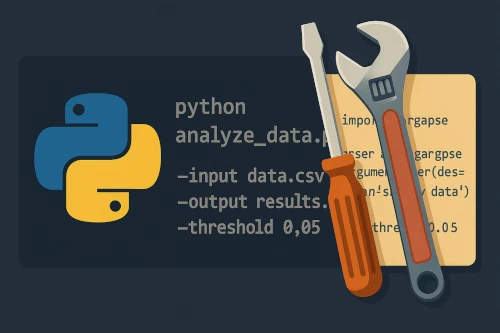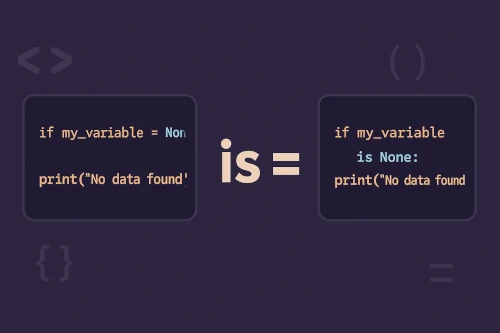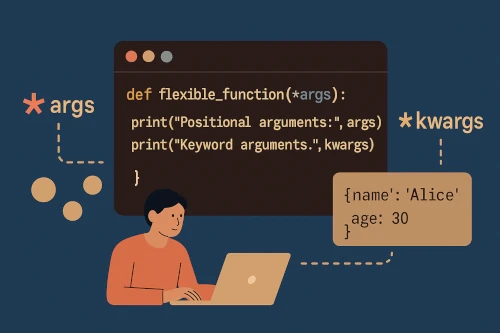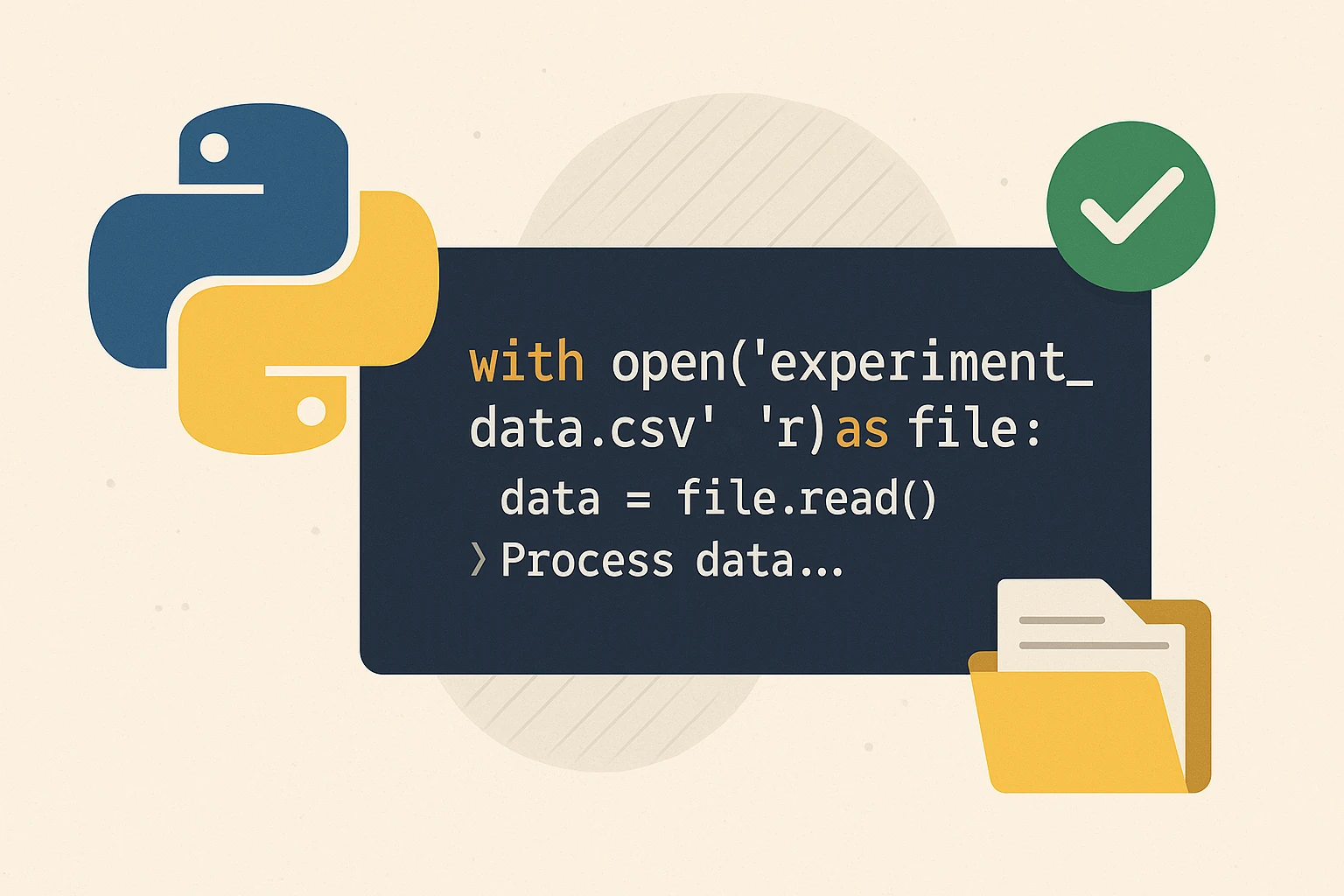
What Are Context Managers and Why Is `with` So Useful?
Picture this: You're processing a massive dataset from your latest experiment. Your script runs for hours, churns through gigabytes of data, and then... crashes right before finishing. When you check your computer, you find dozens of files still open, hogging memory.
Sound familiar? If you've ever forgotten to close a file, release a database connection, or clean up temporary resources, Python's with statement is about to become your new best friend.
In this post, we'll explore what context managers are, why the with statement is so powerful, and how they can make your research code more reliable and professional.
What's the Problem We're Solving?
Let's start with a common scenario. You're reading data from a file:
# The old (risky) way
file = open('experiment_data.csv', 'r')
data = file.read()
# Process data...
file.close() # Easy to forget!What happens if your code crashes before reaching file.close()? The file stays open, potentially causing problems.
Here's the same thing with a with statement:
# The safe way
with open('experiment_data.csv', 'r') as file:
data = file.read()
# Process data...
# File automatically closes here, even if something goes wrong!That's the magic of context managers—they guarantee cleanup, no matter what happens.
What Exactly Is a Context Manager?
A context manager is Python's way of saying:
"I'll set something up for you, let you use it, and then clean up afterwards—guaranteed."
The with statement works with any context manager to ensure:
- Setup: Resources are properly initialized
- Usage: You do your work
- Cleanup: Resources are properly released (even if errors occur)
Real Research Examples
Example 1: Processing Multiple Data Files
import pandas as pd
import os
def process_experiment_files(file_list):
results = []
for filename in file_list:
with open(filename, 'r') as file:
# File automatically closes even if pandas fails
try:
df = pd.read_csv(file)
# Process your data
summary = df.describe()
results.append(summary)
except Exception as e:
print(f"Error processing {filename}: {e}")
# File still closes properly!
return resultsExample 2: Database Connections
If you're storing research data in a database:
import sqlite3
# Without context manager (risky)
conn = sqlite3.connect('research.db')
cursor = conn.cursor()
cursor.execute("SELECT * FROM experiments")
results = cursor.fetchall()
conn.close() # What if there's an error above?
# With context manager (safe)
with sqlite3.connect('research.db') as conn:
cursor = conn.cursor()
cursor.execute("SELECT * FROM experiments")
results = cursor.fetchall()
# Connection automatically closes and commits!Example 3: Temporary Directories
Creating temporary files for intermediate processing:
import tempfile
import os
with tempfile.TemporaryDirectory() as temp_dir:
# Create temporary files for processing
temp_file = os.path.join(temp_dir, 'processing.tmp')
with open(temp_file, 'w') as f:
f.write("Intermediate results...")
# Do more processing...
# Temporary directory and all files automatically deleted!Built-in Context Managers You Should Know
Python comes with many useful context managers:
open()- File handlingsqlite3.connect()- Database connectionstempfile.TemporaryFile()- Temporary filesthreading.Lock()- Thread synchronizationdecimal.localcontext()- Precision control
Creating Your Own Context Manager
Sometimes you need custom setup/cleanup. Here's a simple example for timing code execution:
import time
from contextlib import contextmanager
@contextmanager
def timer(description):
start = time.time()
print(f"Starting: {description}")
try:
yield
finally:
end = time.time()
print(f"Finished: {description} in {end-start:.2f} seconds")
# Use it like this:
with timer("Processing large dataset"):
# Your time-consuming code here
time.sleep(2) # Simulating work
# Output:
# Starting: Processing large dataset
# Finished: Processing large dataset in 2.00 secondsCommon Research Use Cases
1. Safe File Processing Pipelines
def process_data_pipeline(input_file, output_file):
with open(input_file, 'r') as infile, open(output_file, 'w') as outfile:
# Both files automatically close
for line in infile:
processed_line = process(line)
outfile.write(processed_line)2. Resource Management in Simulations
@contextmanager
def simulation_environment(config):
# Setup simulation
env = initialize_simulation(config)
print("Simulation environment ready")
try:
yield env
finally:
# Cleanup
env.save_results()
env.cleanup()
print("Simulation environment cleaned up")
with simulation_environment(my_config) as sim:
sim.run_experiment()
# Automatic cleanup guaranteed!Why This Matters for Your Research
Using context managers makes your code:
- Reliable: Resources are always cleaned up properly
- Readable: Clear setup and teardown patterns
- Robust: Handles errors gracefully
- Professional: No more resource leaks or forgotten cleanup
TL;DR
- Context managers guarantee cleanup with the
withstatement - They prevent resource leaks (open files, database connections, etc.)
- Python has many built-in context managers for common tasks
- You can create custom ones for specialized cleanup needs
- Essential for reliable, professional research code
Quick Practice
Next time you write code that opens a file, try replacing this:
file = open('data.txt', 'r')
content = file.read()
file.close()With this:
with open('data.txt', 'r') as file:
content = file.read()Notice how much cleaner it looks? And it's safer too!
Final Thought
Context managers might seem like a small detail, but they're the difference between code that sometimes works and code that always works reliably. In research, where you might be processing data for hours or days, that reliability is crucial.
The with statement is Python's way of being a responsible citizen—it cleans up after itself. Your future self (and your computer's memory) will thank you! 🧹

